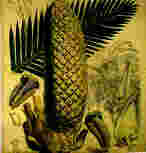 Illustration of Dioon edule from the Botanical Magazine 101, tab.6184, (1875) (1). | Dioon edule Lindley 1843Common NamesTaxonomic notesType species of the genus. Closely related to D. merolae and D. holmgrenii, which all have leaves "rather stiff and erect or semi-erect, with stiff, sharp-pointed leaflets closely spaced and often overlapping (i.e., imbricated)" (2). A diverse species; several varieties have been described. Jones (1) recognizes one variety, Dioon edule var. angustifolium (Miquel) Miquel 1848 (syn: D. angustifolium Miquel).DescriptionMedium-sized cycad with erect or reclining trunk 1-1.5(-3) m tall and 20-30 cm diameter. Young leaves pale green, shortly hairy. Mature leaves 15-20 in a stiff, obliquely erect crown, 0.7-1.6 m long, stiff, rigid, light green or glaucous, flat in cross-section, straight in profile, broadest near the middle and tapered to each end; petiole 10-15 cm long, swollen at the base, lacking prickles; leaflets 120-160 on each leaf, moderately spaced but those toward the apex often crowded and overlapping, inserted at 60-90° to the rachis, lacking marginal spines; median leaflets 6-12 cm by 6-10 mm, linear to linear-lanceolate, leathery, tapered and long-acuminate, gradually reduced in length toward the base of the leaf. Male cones 20-40 × 6-10 cm cylindical; sporophylls 2-3 cm long with upcurved pointed tips. Female cones 20-35 × 12-20 cm, ovoid, wooly; sporophylls 5-8.5 cm long; peduncle 8-12 cm long. Seeds 2.5-3.5 × 2-2.5 cm, ovoid (1, 2).Var. angustifolium differs from the type in having narrower leaflets (6-11 cm × 4-6 mm) that are generally glaucous when young and inserted to the rachis at an acute angle; and in having smaller seeds (about 2 × 2 cm) (1). RangeMexico: widely distributed in the Sierra Madre Oriental from sea level to 1500m. This variety is found in central Veracruz, Queretaro, northern Hidalgo, San Luis Potosi and southern Tamaulipas. Most commonly found in tropical deciduous and oak forests. Var. angustifolium is restricted to the northern Sierra Medre Oriental, in parts of Tamaulipas and Nuevo Leon at 200-1500m (1).Big TreeEthnobotanyYoung seeds are ground and cooked into tortillas. Fronds are used for decoration, especially in religious ceremonies. Western cultures have widely adopted this variety as an ornamental (1).ObservationsA common species in collections. Have not seen in habitat.Remarks"The foliage is characteristically gray-green to glaucous, a feature of many cycad forms adapted to xeric conditions that is also to be noted in some macrozamias and encephalartoses, and the species in this complex are often found in harsh, dry habitats in eastern Mexico" (2).Citations(1) Jones 1993.(2) Norstog & Nichols 1997. |
[Dioon] [Zamiaceae] [home] This page is from the Gymnosperm Database |